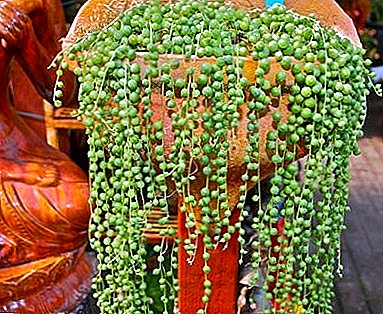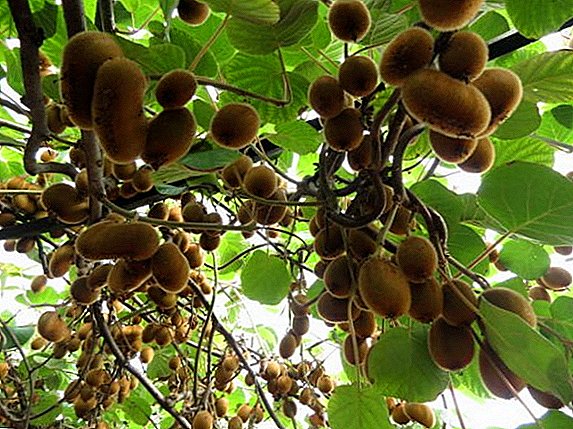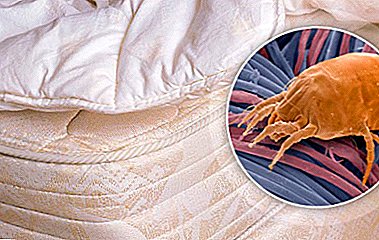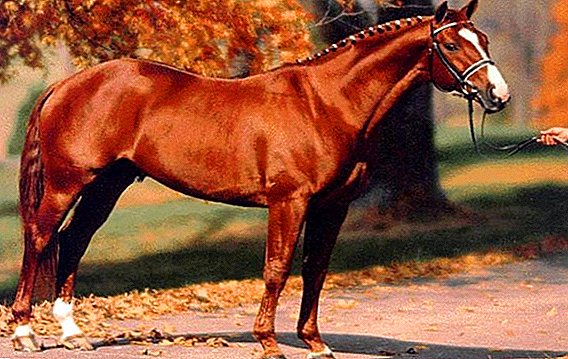 In small farms and large cattle farms, machine milking machines are used. They ensure the safety of raw milk, its purity, fast and safe milking process. Milking machines differ in terms of placement, machine tools, lines of milk lines and the magnitude of the vacuum in the system. This article will discuss the most popular types of milking parlors, their classification and the basic principles of machine milking of cattle.
In small farms and large cattle farms, machine milking machines are used. They ensure the safety of raw milk, its purity, fast and safe milking process. Milking machines differ in terms of placement, machine tools, lines of milk lines and the magnitude of the vacuum in the system. This article will discuss the most popular types of milking parlors, their classification and the basic principles of machine milking of cattle.
What is a milking machine (hall)
A milking machine is a mechanism that serves to pump out milk from the udder under the action of a vacuum. The installation consists of a complex of automata that are responsible for washing the udder, donating the first milk streams, their utilization and full milking for 4-5 minutes.  The milking machine also provides transportation of milked milk through pneumatic milk lines to the dairy shop and its associated cooling. The milking parlor is a large-scale equipment for automatic milking, which is controlled through a computer.
The milking machine also provides transportation of milked milk through pneumatic milk lines to the dairy shop and its associated cooling. The milking parlor is a large-scale equipment for automatic milking, which is controlled through a computer.
Important! To choose the right installation for the farm, you need to decide on its productivity: too productive will bring the farm a loss, and weak do not have time to serve the livestock.
Classification
Milking machines are distinguished by structural features.
By type of milking machines
A milking machine can be designed for a different number of animals, therefore, the machines described below are used on large and small farms.
Customized
There are both stationary and mobile. In such installations, the machines are located in two parallel rows. Each machine has a separate input and output for the animal. The milking installation "Tandem" belongs to the individual.
Find out if milking machines are good for cows, what makes AID 2 milking machine good, and also, learn how to make a milking machine with your own hands.
Group
They differ in the number of places in one machine. The group machine can accept at the same time two and more cows. The group installation consists of parallel-mounted machines that are mounted in two rows. This setting is called "Herringbone".  There is also a circular "Yolochka" in which the machines form a closed ring or square.
There is also a circular "Yolochka" in which the machines form a closed ring or square.
Did you know? For the first time, mankind tried to improve the milking process at the beginning of the XIX century. At that time, special tubes were invented and inserted into the sphincters of cow nipples, and the milk from them was poured out under the action of the force of the force. Such tubes were made of wood and metals, so the milking process for animals was associated with severe discomfort and serious diseases later.
At the place of milking
Depending on whether or not the animals are tethered, the settings are as follows.
Stationary
Provide complete control over the milking process. They can be placed in dairy workshops and directly in barns in order to minimize animal stress. Stationary devices in barns are used when keeping on a leash. With their help, milk is collected in milk lines or cans.
Mobile
In winter, they perform the functions of stationary devices, and in the summer season they are transferred to pasture. Mobile devices are called milking stations. They collect milk first in cans and then into general tank trucks that transport raw materials to the shop for cooling.
The largest vacuum in the system
The higher the vacuum level, the faster the pumping out of milk occurs, but milk loss can be a stressful process for a cow. 
Low vacuum
Differ in low pressure on the nipples - no more than 40 kPa. Glasses of low-vacuum apparatus are transparent and light: this reduces udder retention and helps to respond to the cessation of milk loss instantly.
Injury of alveolar tissue is reduced, as there is no need for nipple rubber. Low vacuum installations can be used for milking cattle with non-standard nipples, such as horses and goats.
Important! High vacuum teat cups rub the nipple sphincter in cows. The milk production process becomes painful for animals and they lose in productivity.
High vacuum
Provide quick jogging of milk. They work with a vacuum above 60 kPa, which, with frequent use, adversely affects the internal tissues of the udder. High vacuum apparatuses are used on farms less and less, as they not only injure animals, but also worsen the quality of milk, foaming it and collapsing the protein phase.
By placing the lines of milk
The pipes of the milk pipeline are laid relative to the average level of the udder of the cow to maintain pressure in the system. 
With top location
Cause a significant pressure drop in the teat cups, as they are 1.5-2 meters above the level of the udder. They can cause discomfort to a cow during milking, since they carry out the change on different nipples unevenly.
From the bottom
Installations of this type minimize vacuum fluctuations in glasses, since they are practically on a par with udders and milking glasses. Milk delivery to the milking department through low milk lines requires more energy, but the animal feels comfortable during milking.
Did you know? For the first time the analogue of the present milking machine was patented in the 1850s. Two Englishmen presented a device to the world, which consisted of rubber teat cups and a pump that had to be manually rocked. In the 60s of the XIX century, another device appeared - a one-piece cup-diaphragm with holes for nipples, which was put on the entire udder and gradually squeezed it.
Technology milking cows in milking parlors
Milking cows on milking machines includes the preparation of the udder, milking and removal of the teat cups.
- Training. The udder is washed away with warm water from a special hose with a nozzle and gently massaged in order to stimulate milk flow. If the udder does not swell from undermining, it is massaged more intensively, imitating the milking process.
- Surrender. It is held in a separate container with a filter to identify mastitis milk. Pass the first few streams of stagnant milk from each nipple, the capacity is set aside.
- Putting on glasses. They are put on after switching on the device, first on the rear, then on the front nipples.
- Milking. Lasts 4-5 minutes. Completion of the milk flow can be determined by the way the glasses are drawn in first, the nipples, and then the emptied udder.
- Glasses removal. The milk hose is blocked, air is pumped into the glasses, and they are removed without effort.
Important! After the glasses are removed, it is necessary to open the milk hose for a few more seconds so that the remnants of the raw materials go into the common tank along the milk line, and only then send the glasses for washing.
Milking machines for cows
The main differences between installations are in the number of cows that they can serve at the same time, and the way they are placed. 
ADM-8
Suitable for servicing large-scale farms with a population of at least two hundred. The stationary device with vacuum and dairy lines. The supply of milk is pneumatic, meters are installed on the pipes. In each milk line, filters are installed for the primary separation of foreign particles.
There is a common flask to remove air bubbles. The average lifespan of the ADM-8 is 8 years, the capacity for 200 heads is more than 110 milkings per hour. It takes 1.5 kW / h per milking, four machines are required for maintenance.  Pros:
Pros:
- Lightness and mobility. The installation weighs no more than 2 tons and allows you to leave the feed passage free during milking.
- Disinfection. It is activated automatically with flushing after the completion of the milking cycle.
- Sample raw materials. The ability to take it is present even during the delivery.
- Dairy department. Collects raw materials immediately after expiration without first pouring into cans.
Minuses:
- High vacuum milking provokes stress in animals and injures the glandular tissue of the udder.
- Short service life counters. The discrepancies in the actual and accounting quantity of milk begin after about 30 thousand liters passed through the counter.
- Weak vacuum pumps need regular maintenance checks..
Did you know? At the beginning of the 20th century, an American farmer by the name of Colvin developed an apparatus that worked with electrical energy and provided a uniform vacuum in metal teat cups with gutta-percha flanges. A patent for this invention was sold for 5 thousand dollars - about 100 thousand dollars in our time.
UDM-200
The device is designed for sifting into the milk line - stationary, with galvanized dairy and vacuum lines. Accounting of raw materials is carried out using a dispenser. The pump is designed for pumping 60 cubic meters of raw materials per hour. At the same time can hold up to 200 milkings.  Pros:
Pros:
- The purity of the raw materials. Immediately from the nipples through the glasses the milk enters through a sealed milk line into the general tank.
- Mean pressure. It is at the level of 47 kPa, so the cow is not injured when milking.
- Flushing It is carried out automatically by taking water from the water supply system.
Minuses:
- Lack of filters. There is a need for additional cleaning of raw materials.
- Bulkiness During milking, the feed passages are barred.
"Yolochka" UDA-16A
It is used on farms with tethered cows in group machines. Carries out the distribution of feed, cleaning equipment rinsing, automatic undermining the udder, removing the teat cups and pre-processing of raw milk.  It has a capacity of 1.1 kW / h, 16 dispensers for the distribution of feed, simultaneously serves from 200 to 350 heads. Milk receivers are designed for 10 thousand liters each. The device is serviced by two operators simultaneously.
It has a capacity of 1.1 kW / h, 16 dispensers for the distribution of feed, simultaneously serves from 200 to 350 heads. Milk receivers are designed for 10 thousand liters each. The device is serviced by two operators simultaneously.
Important! The average frequency of suckling by the calf of the udder of the cow is kept within 60 pulsations per minute. The pulsator of the milking machine should be tuned to the same frequency so that the cow is comfortable.
Pros:
- Detection of mastitis milk. The compact analysis system checks milk, identifies and isolates poor quality raw materials.
- Filtration. It is carried out directly in milk lines, clean raw materials are fed into the common tank.
- Cooling system. Prolongs the bactericidal phase of milk.
- Massage system Stimulates milk flow, accelerating the process of milking.
- Infrared sensors. Responsible for regulating the intensity of giving milk, automatic connection and disconnection of teat cups.
Minuses:
- High price - The price for the installation of the "Yolochka" starts from $ 30,000.
- Bulkiness - can not be installed in the barn.
Carousel UDA-100
It bears the name "Carousel" due to the fact that it is installed in round milking halls. It has a rotating milking platform on which cows are located. Operators alternately connect the glasses to the udder of each cow, and at the end of the milking they are removed.  Best for loose-housing farms. The drive platform has a power of 4 kW, provides one full turn in six minutes of milking. It can simultaneously serve up to 75 heads.
Best for loose-housing farms. The drive platform has a power of 4 kW, provides one full turn in six minutes of milking. It can simultaneously serve up to 75 heads.
Did you know? In Scotland for 30 years, used the device, invented in the late XVIII century. It was improved and released new models, but in general, the design of the device has not changed.
Pros:
- Automatic finishing - after the main milking, the power of the vacuum is reduced and doping is carried out in the milk line.
- Control - All animals are in smooth motion, fixed in individual machines.
Minuses:
- Operators - for the full maintenance of the installation should be five.
- Bulkiness - installation occupies the entire hall, has a complex structure and needs constant technical inspection.
"Tandem" UDA-8A
Designed for milking in group machines. Collects the raw material, cooling and filtering it; it can be equipped with a feed dispenser. When servicing a herd of 300 animals per hour, it can hold more than 100 milkings. It consumes 2.2 kW of power, gives a vacuum of 52 Pa, has glass milk lines.  Pros:
Pros:
- Pneumatic gate - provide automatic launch of livestock in the installation.
- Automatic lines - washed milk lines immediately after the completion of the milking cycle, wash the udder before milking.
- Vacuum Stabilization - eliminates the pressure difference in the teat cups to relieve animals from discomfort.
- Computer management. Carries out control over milking - instantly determines mastitis milk after receiving a signal from the analysis system, turns off glasses from cows that have passed milking.
Minuses:
- Bulkiness - occupies the entire milking shop, can not be installed in the barn.
- Static - can be used only in the cold season indoors, not suitable for the pasture season.
Important! When milking heifers, pressure should be set at 46-48 Pa, since their udder has not yet been developed, and the skin can be injured under considerable pressure.
"Parallel"
A colossal installation for maintaining farms with a minimum livestock of a thousand animals. The milking machines are located at a distance of 70 cm from each other and at a slight angle in order to facilitate the putting on of the glasses.
It requires three operators for maintenance, has a capacity of 1.3 kW / h. Uses pressure within 42 Pa - refers to the low-vacuum installation.  Pros:
Pros:
- Glass milk tank. Glass is an inert material that does not change the composition and structure of raw materials.
- Automatic flushing. The system is installed separately and provides additional disinfection.
- Milk counters. Miniature devices are placed in the suspended part of teat cups, they keep records of milk individually for each animal.
- Lifting floor. The pneumatic system lifts the platform along with the operator, facilitating the milking process.
Minuses
- High price - The price of these installations starts from 40 000 dollars.
- Maintenance difficulty - carry out warranty repair of this installation can only professional technicians.
"Doyushka" 1P
Compact portable installation designed for milking cows on small dairy farms. In an hour can serve from 5 to 8 cows. It has a power of 0.5 kW, uses a pressure in the range of 50 Pa, and therefore refers to installations with an average vacuum.
"Doyushka" weighs 50 kilograms, gives a pulsation about 60 times per minute.  Pros:
Pros:
- Low power consumption. Energy consumption during milking is comparable to household use of a microwave.
- Sustainability. The center of gravity of the installation is placed in such a way that even a kinked animal cannot turn it over.
- Asynchronous motor. It is mounted in the back of the device, so it does not overheat and does not get clogged.
- Ease. One person can use the “doyushka” - this installation is located on a trolley with wheels.
Minuses:
- Slow work. In one hour you can milk a maximum of 10 cows.
- Power cable. It has a small length, so in addition to it, you have to buy an extension cord.
- Opaque tank. Unlike glass pipelines and ergoplastic cans, the “Doyushka” does not allow to know the level of milk during milking.
Important! The cuff length of the teat cup should be the same as the length of the cow nipple. Glasses are of different lengths, and they need to be selected for each breed.
Mobile installation DeLaval MMU
Treats the mobile milking machines, has the used power of 0,65 kW. The pressure during milking varies between 42-45 Pa, that is, close to the natural sucking calf. Pulsator is absent, if necessary, can be installed separately.  Pros:
Pros:
- Maneuverability. Installation has wheels and the handle, is easily transported by one person.
- Simple construction. There are few details in the installation in question, for its maintenance you do not need to contact a professional technician.
- Muffler. Reducing the noise level has a beneficial effect on cows - they are not subjected to stress and give off milk better.
Minuses:
- Low productivity. For an hour the installation is able to spend from 7 to 10 milkings.
- Unreliable engine. In models made before 2010, the engines often fail. In later models, this problem is solved.
Did you know? Anna Baldwin of New Jersey was the first American inventor to patent a successful milking machine in the 50s of the XIX century. This unit consisted of a bucket, glasses and a simple pump responsible for the vacuum. The vacuum was constant, the milk was sucked out by a continuous stream, not by natural shocks, and the whole idea was imperfect, but it marked the beginning of a whole series of useful discoveries.
Milking machines are used on all dairy cattle farms. They facilitate labor and provide high quality raw milk. Milking machines are of different designs and differ in their productivity.
With the same milking technology, they give different results. Before you buy such a device in your farm, you need to carefully compare its specifications with competitive installations.












